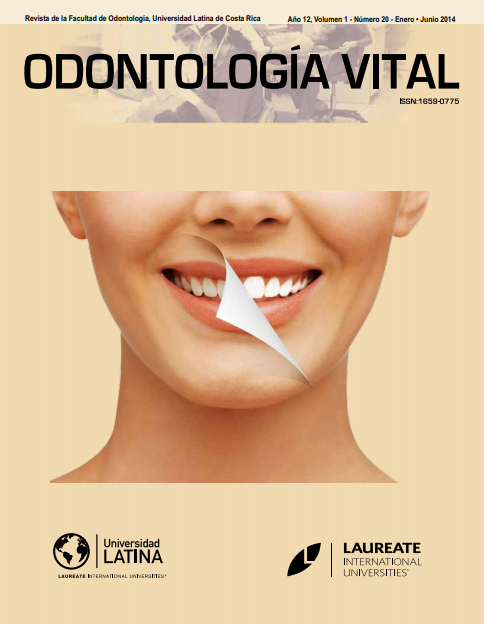Use of bioceramics (Biodentine™) in apicectomy retrodentary obturation clinical case report
DOI:
https://doi.org/10.59334/ROV.v1i20.303Keywords:
Biodentine™, Apicoectomy, retrograde fillingAbstract
The healing of soft and hard tissues is the expected outcome after performing an apicectomy, and one of the key points to achieve this healing is having a tridimensional seal that prevents the entrance and outlet of bacteria.
Currently there are numerous materials used to this purpose but none has all the characteristics of an ideal material. The objective of this article is to present a clinical case of an apicectomy using Biodentine™ as a retrograde filling material.
Downloads
References
Astrup, I. I., Knutssøn, C. H., & Osen, T. B. (2012). Biodentine™ as a root-end filling material. Tesis de Maetria Universidad I Tromsø.
Bodrumlu, E. (2008). Biocompatibility of retrograde root filling materials: A review. Aus Endod J, 34, 30-35. https://doi.org/10.1111/j.1747-4477.2007.00085.x
Brave, D., Nasseh, A. A., & Koch, K. (2012). A review of of bioceramic technology in endodontics. roots, 4, 6-12.
Chaple Gil, A. M., & Herrero Herrera, L. (2007). Generalidades del Agregado de Trióxido Mineral (MTA) y su aplicación en odontología: revisión de literatura. Acta Odontológica Venezolana, 45(3), 1-8.
Chong, B. S., & Pitt Ford, T. R. (2005). Root-end fillin materials: rationale and tissue reponse. Endod Topics, 11, 114-130. https://doi.org/10.1111/j.1601-1546.2005.00164.x
Damas, B. A., Wheather, M. A., Bringas, J. S., & Hoen, M. M. (2011). Cytotoxiciti comparison of Mineral Trioxide Aggregates and EndoSequence Bioceramic Root Repair Materials. J Endod, 37(3), 372-375. https://doi.org/10.1016/j.joen.2010.11.027
Dammaschke, T. (2012). Biodentine™ -an overview. Septodont Case Studies Collection(3), 4-9.
Dammaschke, T. (2012). Root-end Filling with a New Bioactive Cement. Inside Dentistry, 8(3).
Goel, M., Bala, S., Sachdeva, G., & Shweta. (2011). Comperative Evaluation of MTA, Calcium Hydroxide And Port-land Cement As A Root End Filling Materials: A Comprehensive Review. Indian J of Dent Sciences, 3(5), 83-88.
Grech, L., Mallia, B., & Camilleri, J. (2012). Characterization of set Intermediate Restorative Material, Biodentine, Bioaggregate and a prototype calcium silicate cement for use as root-end filling materials. Int Endod J, 1-10.
Guneser, M. B., Akbulut, M. B., & Eldeniz, A. U. (2013). Effect of various endodontic irrigants on the push-out bond strenght of Biodentine and conventional root perforation repair materials. J Endod, 1-5. https://doi.org/10.1016/j.joen.2012.11.033
Laurent, P., Camps, J., & About, I. (2012). Biodentine™ induces TGF-b1 release from human pulp cells and early dental pulp mineralization. Int Endod J, 45, 439-448. https://doi.org/10.1111/j.1365-2591.2011.01995.x
Laurent, P., Camps, J., De Méo, M., Déjou, J., & About, I. (2008). Induction of specific cell responses to a Ca3SiO5 based posterior restorative material. Dental Materials, 24, 1486-1494. https://doi.org/10.1016/j.dental.2008.02.020
Ma, J., Shen, Y., Stojicic, S., & Haapasalo, M. (2011). Biocompatibility of Two Noverl Root Repair Materials. J Endod, 37(6), 793-798. https://doi.org/10.1016/j.joen.2011.02.029
Nowicka, A., Lipski, M., Parafiniuk, M., Sportniak-Tutak, K., Lichota, D., Kosierkiewicz, A., . . . Buczkowska-Radl-inska, J. (2013). Response of human dental pulp capped with biodentine and mineral trioxide aggregate. J Endod, 39(6), 743-747. https://doi.org/10.1016/j.joen.2013.01.005
Parirokh, M., & Torabinejad, M. (2010). Mineral Trioxide Aggregate: A comprehensive literature review-part I: Chemical, physical and antibacterial properties. J Endod, 36(1), 16-27. https://doi.org/10.1016/j.joen.2009.09.006
Park, J.-W., Hong, S.-H., Kim, J.-H., Lee, S.-J., & Shin, S.-J. (2010). X-Ray diffraction analysis of White ProRoot MTA and Diadent BioAggregate. Oral Surg Oral Med Oral Pathol Oral Radiol Endod, 109, 155-158. https://doi.org/10.1016/j.tripleo.2009.08.039
Pelegri, M. (2011). BIODENTINE – Eficaz tecnología en biosilicatos. Canal Abierto, 24, 16-19.
Predelle-Plasse, N., Tran, X., Colon, P., Laurent, P., Aubut, V., About, I., . . . Septier, D. (2009). Emerging trends in (bio) material research. En M. Goldberg (Ed.), Biocompatibility or cytotoxic effects of dental composites (1a ed., págs. 184-203). Coxmorr Publishing Co.
Zhou, H.-m., Shen, Y., Wang, Z.-j., Li, L., Zheng, Y.-f., Hakkinen, L., & Haapasalo, M. (2013). In vitro ytotoxicity evaluation of a novel root repair material. J Endod, 1-6.
Downloads
Published
How to Cite
Issue
Section
License
Copyright (c) 2014 Odontología Vital

This work is licensed under a Creative Commons Attribution 4.0 International License.
Authors who publish with Odontología Vital agree to the following terms:
- Authors retain the copyright and grant Universidad Latina de Costa Rica the right of first publication, with the work simultaneously licensed under a Creative Commons Attribution 4.0 International license (CC BY 4.0) that allows others to share the work with an acknowledgement of the work's authorship and initial publication in this journal.
- Authors are able to enter into separate, additional contractual arrangements for the non-exclusive distribution of the Odontología Vital's published version of the work (e.g., post it to an institutional repository or publish it in a book), with an acknowledgement of its initial publication.
- Authors are permitted and encouraged to post their work online (e.g., in institutional repositories or on their website) prior to and during the submission process, as it can lead to productive exchanges, as well as earlier and greater citation of published work.
Métricas alternativas











